AMD Radeon HD 7870 GHz Edition & Radeon HD 7850 Review: Rounding Out Southern Islands
by Ryan Smith on March 5, 2012 12:01 AM ESTPower, Temperature, & Noise
As always, we wrap up our look at a new video card with a look at the physical performance attributes: power consumption, temperatures, and noise. Thanks to TSMC’s 28nm process AMD has been able to offer 6900 series performance on a much smaller chip, but what has that done to power consumption and all of its related properties? Let’s find out.
Please note that we’re including our 7870-based 7850 in these charts, even though none of AMD’s partners will be shipping a card in this exact configuration. Power consumption should be nearly identical to shipping cards, but temperatures and noise readings are going to be significantly different since most of those cards will be using open air coolers.
| Radeon HD 7800 Series Voltages | ||||
| Ref 7870 Load | Ref 7850 Load | Ref 7870 Idle | ||
| 1.219v | 1.213v | 0.85v | ||
When getting a voltage reading on our 7800 cards through GPU-Z, it was interesting to note that the load voltage was almost identical between the two cards: 1.219v versus 1.213v. While we believe GPU-Z is giving us the right readings, we’re not sure whether the 7850 voltages are the same we’ll be seeing on shipping cards because of the PCB differences.

Idle power consumption looks quite good, as you’d expect from GCN. Idle power consumption is virtually identical to the 7900 series at the wall, and only the 7700 series can beat 112W. This further goes to show just how much progress has been made with idle power consumption – the Cayman based 6900 series had good idle power consumption for its time, and yet the 7800 series beats it by 5W+ at the wall.
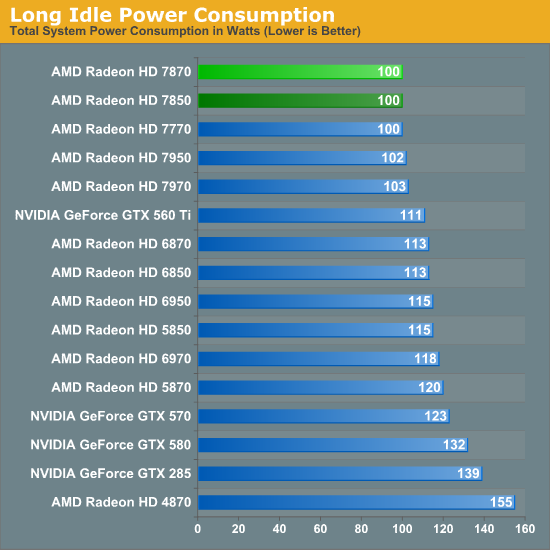
Long idle power consumption is virtually identical with the rest of the Southern Islands cards thanks to AMD’s ZeroCore Power technology. The next closest card is the GTX 560 Ti, and that’s at nearly 10W higher.
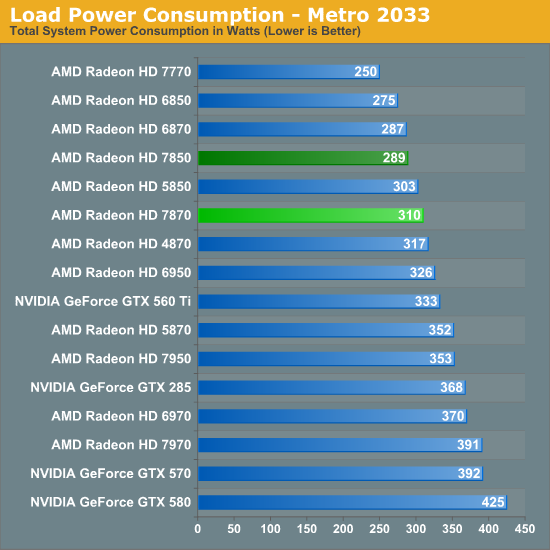
Moving on to load power testing, we have Metro 2033. Load power consumption here is about where you’d expect it to be, with the 7800 setups drawing more at the wall than the 6800 setups, but less than the 7900 and 6900 series. This is largely a consequence of performance, as the higher rendering performance of the 7800 series versus the 6800 series drives up CPU power consumption in order to generate more frames.
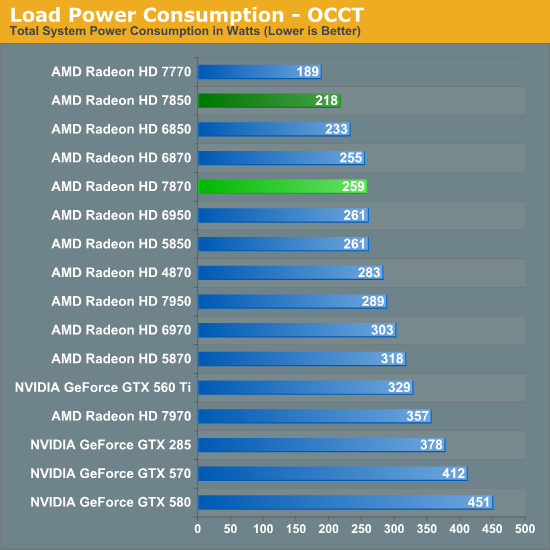
OCCT on the other hand gives us a more purified look at power consumption, and as you’d expect for 28nm it looks good. The 7870 ends up drawing only a few more watts at the wall compared to the 6870, showcasing the fact that the 7800 series is a drop-in replacement for the 6800 series from a power consumption perspective. The 7850 looks even better, capping out at 15W below the 6850, most likely as a result of PowerTune keeping the card firmly at 150W. Though it’s interesting to note that the measurements at the wall don’t perfectly align with the differences in PowerTune limits, with the 7850 drawing 30W more than the 7770 at the wall compared to a 50W PT difference, while the 7950 draws 30W more at the wall over the 7870 even though there’s only supposed to be a 10W PT difference.
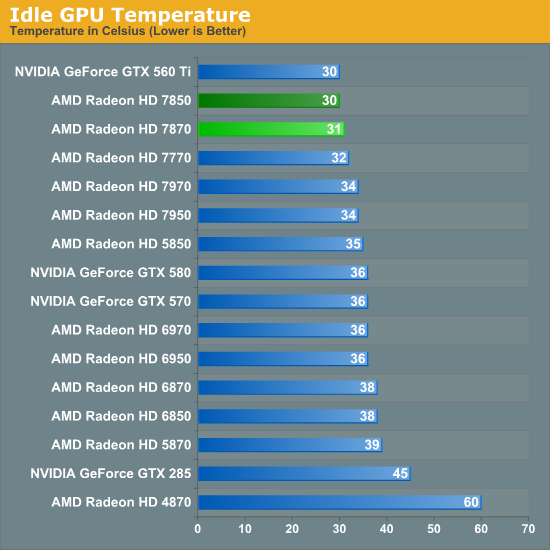
AMD’s latest generation blowers do quite well with idle temperatures and we can see it here. At 30C for the 7850 it’s every bit as cool as the GTX 560 Ti, while the entire 7800 series is around 5-8C cooler than the 6900.
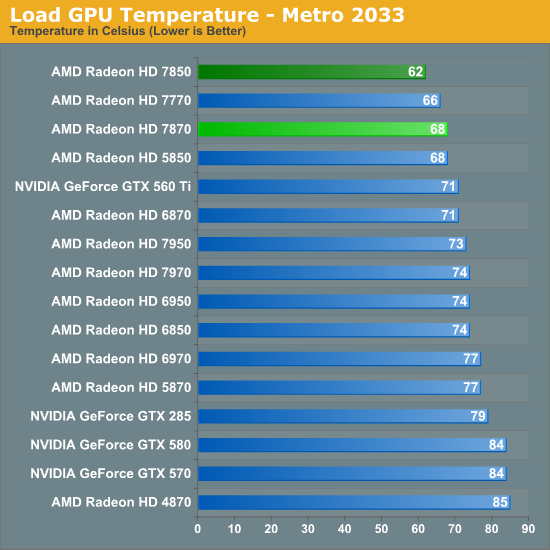
Under load, Metro temperatures are also quite good. At 62C the 7850 is the coolest card in this performance class, but keep in mind that it’s basically using an oversized cooler; retail cards will be open air coolers with much different characteristics. Otherwise at 68C the 7870 is still among the coolest cards, coming ahead of even the historically cool GTX 560 Ti, never mind the much hotter 6900 series.

Load temperatures climb under OCCT, but again the 7800 series is among the coolest temperatures we see. Here we see the 7870 peak at 73C, whereas its last generation counterpart would be at 80C and the GTX 570 at a toasty 87C.
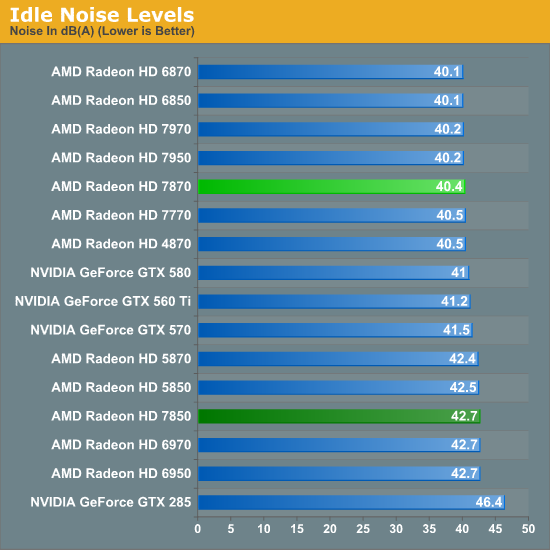
Moving on to noise testing, there are no major surprises at idle, with the 7870 hugging 40db. For whatever reason the 7850’s minimum fan state is roughly 200RPM higher than the 7870’s, but since no one will be using this cooler it’s not a significant result.
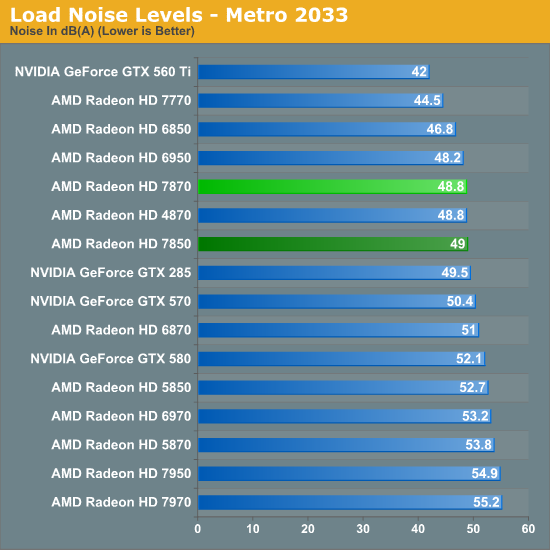
Consistent with AMD’s other 7000 series cards, we’re once again seeing the consequences of AMD’s aggressive cooling policies coupled with the use of a blower. At 48.8dB the 7870 is still quieter than the blower-based 6870, but it’s significantly louder than the open air cooled GTX 560 Ti, even though the latter consumes far more power and generates far more heat. This doesn’t make the use of a blower the wrong choice, but combined with aggressive cooling policies it does hurt AMD. The GTX 570, in spite of using much more power than the 7870, is only less than 2dB louder even though it too uses a blower.

Last, but not least we have our OCCT noise results. Unlike Metro the 7800 series does better on a relative basis here, but this is mostly because NVIDIA doesn’t have a power throttling system quite like PowerTune. At 51.9dB the 7870 is not the quietest card, but it still manages to beat the 6970 and the PowerTune-less 6870.
All things considered there are no great surprises here on a relative basis, as the 7800 series performs like we’d expect for a blower based sub-200W video card. Due to TSMC's 28nm process AMD greatly improves on their performance/power and performance/noise ratios with the 7800 series compared to the 6800 and 6900 series, while for their power class the 7800 series is slightly ahead of the pack on both power consumption and noise.
With that said, keep in mind that since most of AMD’s partners will be using open air coolers these results won’t be applicable to most retail cards. So for the temp/noise characteristics of retail cards you’ll want to look at individual card reviews when those start appearing later this month. This is particularly true for the 7950, where all of the retail cards will be using a different design than our sample.










173 Comments
View All Comments
Beenthere - Tuesday, March 6, 2012 - link
Yes at the moment AMD is most definitely getting top dollar for these Vid cards just as Intel does all of the time on their CPUs - until they have competition.In case you didn't notice the new 7xxx series cards surpass Nvidia's current offerings in just about every category so this IS a step forward in performance at the same or lower prices.
MMoudry - Tuesday, March 6, 2012 - link
Hello,Does anybody know if those two cards would work in crossfire? The Crossfire compatibility chat is not yet up to date and I can't seem to find that information anywhere....
Sources:
http://sites.amd.com/us/game/technology/Pages/cros...
MM
Hrel - Tuesday, March 6, 2012 - link
Hd6870 and gtx 560 can be had for 160 and 165 respectively. WHY would anyone want the SIGNIFICANTLY slower 7770? It's not like it's directX 12 or something.Alpert - Tuesday, March 6, 2012 - link
I can understand why so many get it wrong but I can also clearly see.7770 currently retails for $169.99 - $179.99
6870's currently retail for $189.99 - $209.99 original price was $249.99
I just checked these numbers from 3 retailer
7770 is a weaker card then the 6870, sure but performance per dollar is actually a little better with the 7770. Considering the lack of competition from Nvidia why would AMD reduce the price to performance ratio that exists. AMD is selling you more features for a better value card.
When Kepler arrives AMD price's could go down if Nvidia prices it that way. If Kepler is all the #$%^ it's hyped to be AMD will counter it with a price drop then we all win. Looking at ATI/AMD's history something they have always offered the customer, superior price/performance of the competition.
AMD will always be better price to performance for less while Nvidia justifies there inflated prices with CUDA, PhysX, TWIMTBP and of course better driver support.
The value of performance will remain as is. Like a commodity on the stock exchange, why would Nvidia devalue there own stock or at least so quickly?
Hrel - Wednesday, March 7, 2012 - link
I checked the prices I listed on newegg just before posting that. Not sure where you got your prices from, but shop newegg in the future... that way you aren't wrong :p.bozolino - Tuesday, March 6, 2012 - link
There is something REALLY odd about 560 TI numbers on ELDERS SCROLL V.Under 7770 REVIEW it shows 7770 right above 550 TI and on the top of all them is a standard GTX 560 with like 46 fps and here, on this review it shows the GTX 560 TI with like 36 fps. The settings look just like the same..
Please correct that because it is looking like the GTX 560 TI is worse than the 7770, wich it isnt by at least a mile.
Alpert - Tuesday, March 6, 2012 - link
With a 7770 the power consumption is below that of the Radeon HD 6870 and GeForce GTX 560 Ti, while still delivering the same gameplay experience of those video cards. About 2%-7% slower then 560 Ti.CeriseCogburn - Thursday, March 8, 2012 - link
This isn't HardOCP Alpert.slypher1024 - Wednesday, March 7, 2012 - link
My 5850 still server me well @ 1600x900 res.. Not until these prices drop i'll upgrade..AMD is obviously maximizing profit with these products, seeing that Nvidia next launch is at least 2 months away...
SAD
gammaray - Wednesday, March 7, 2012 - link
Price wars, really?seriously, 250$ for a low end video card and 350$ for a mid range video card, not even the MAIN LINE serie but somewhat weaker versions of their 7900 serie counterpart.
Video card markets have been ripping off consumers in the past years with their super hefty high prices.
it should be like that: 150$ for new low end video cards, 250$ for new mid-range and 350$+ for whatever they want to sell to whoever will always buy the most expensive stuff no matter.
the price of the 6800 should all be below 100$ right now and the 6900 serie prices cut in half .